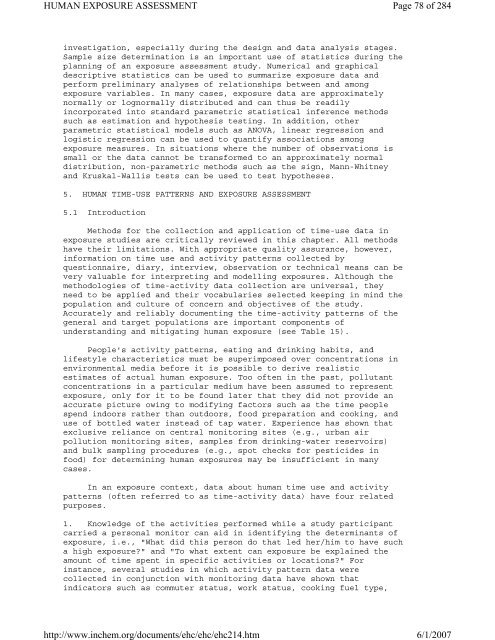Environmental Health Criteria 214
Environmental Health Criteria 214
Environmental Health Criteria 214
Create successful ePaper yourself
Turn your PDF publications into a flip-book with our unique Google optimized e-Paper software.
HUMAN EXPOSURE ASSESSMENT<br />
investigation, especially during the design and data analysis stages.<br />
Sample size determination is an important use of statistics during the<br />
planning of an exposure assessment study. Numerical and graphical<br />
descriptive statistics can be used to summarize exposure data and<br />
perform preliminary analyses of relationships between and among<br />
exposure variables. In many cases, exposure data are approximately<br />
normally or lognormally distributed and can thus be readily<br />
incorporated into standard parametric statistical inference methods<br />
such as estimation and hypothesis testing. In addition, other<br />
parametric statistical models such as ANOVA, linear regression and<br />
logistic regression can be used to quantify associations among<br />
exposure measures. In situations where the number of observations is<br />
small or the data cannot be transformed to an approximately normal<br />
distribution, non-parametric methods such as the sign, Mann-Whitney<br />
and Kruskal-Wallis tests can be used to test hypotheses.<br />
5. HUMAN TIME-USE PATTERNS AND EXPOSURE ASSESSMENT<br />
5.1 Introduction<br />
Methods for the collection and application of time-use data in<br />
exposure studies are critically reviewed in this chapter. All methods<br />
have their limitations. With appropriate quality assurance, however,<br />
information on time use and activity patterns collected by<br />
questionnaire, diary, interview, observation or technical means can be<br />
very valuable for interpreting and modelling exposures. Although the<br />
methodologies of time-activity data collection are universal, they<br />
need to be applied and their vocabularies selected keeping in mind the<br />
population and culture of concern and objectives of the study.<br />
Accurately and reliably documenting the time-activity patterns of the<br />
general and target populations are important components of<br />
understanding and mitigating human exposure (see Table 15).<br />
People's activity patterns, eating and drinking habits, and<br />
lifestyle characteristics must be superimposed over concentrations in<br />
environmental media before it is possible to derive realistic<br />
estimates of actual human exposure. Too often in the past, pollutant<br />
concentrations in a particular medium have been assumed to represent<br />
exposure, only for it to be found later that they did not provide an<br />
accurate picture owing to modifying factors such as the time people<br />
spend indoors rather than outdoors, food preparation and cooking, and<br />
use of bottled water instead of tap water. Experience has shown that<br />
exclusive reliance on central monitoring sites (e.g., urban air<br />
pollution monitoring sites, samples from drinking-water reservoirs)<br />
and bulk sampling procedures (e.g., spot checks for pesticides in<br />
food) for determining human exposures may be insufficient in many<br />
cases.<br />
In an exposure context, data about human time use and activity<br />
patterns (often referred to as time-activity data) have four related<br />
purposes.<br />
1. Knowledge of the activities performed while a study participant<br />
carried a personal monitor can aid in identifying the determinants of<br />
exposure, i.e., "What did this person do that led her/him to have such<br />
a high exposure?" and "To what extent can exposure be explained the<br />
amount of time spent in specific activities or locations?" For<br />
instance, several studies in which activity pattern data were<br />
collected in conjunction with monitoring data have shown that<br />
indicators such as commuter status, work status, cooking fuel type,<br />
http://www.inchem.org/documents/ehc/ehc/ehc<strong>214</strong>.htm<br />
Page 78 of 284<br />
6/1/2007

















